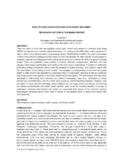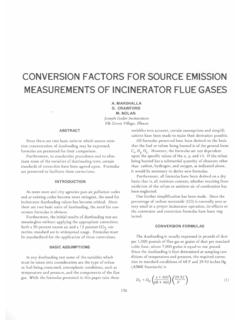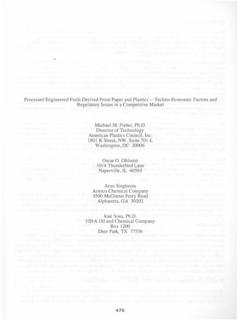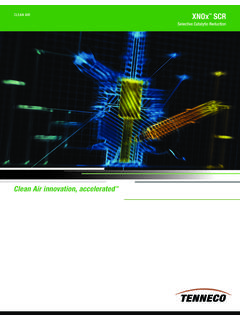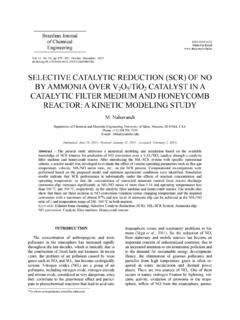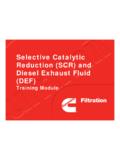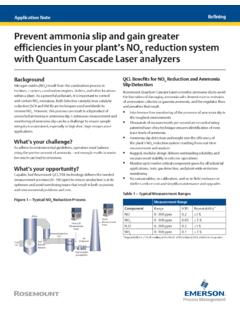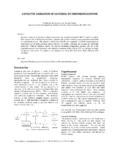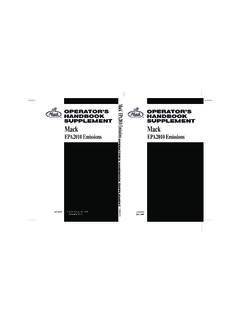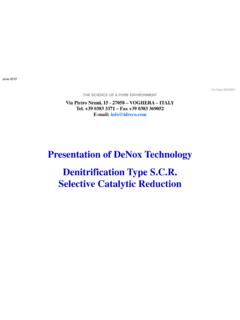Transcription of A Case Study of the Selective Catalytic Reduction …
1 A Case Study of the Selective Catalytic Reduction (SCR) System at the Algonquin Power Energy-From-Waste Facility Principal Author: Janice Hatton Technical Analyst, Waste Management, Region of Peel 7795 Torbram Road Brampton, ON L6T 0B6 Co-Author: Peter Bulionis, P. Eng. Senior Project Manager, Thermal Power, Algonquin Power Systems Inc. 7656 Bramalea Road Brampton, ON L6T 5M5 Abstract The Algonquin Power Energy-From-Waste (APEFW) facility is located in the suburban Toronto, Ontario city of Brampton. It receives approximately 140,000 metric tonnes (154,000 tons) of MSW per year from the Region of Peel (Region) and approximately 10,000 metric tonnes (11,000 tons) per year of international airport waste from the area s two international airports.
2 The APEFW facility commenced initial operations in 1992 and included four, 91 tonne (100 ton) per day Consumat two stage incinerators with heat recovery boilers and a dual-train air pollution control (APC) system consisting of evaporative cooling towers, venturi reactors and fabric filter baghouses. The APEFW facility expanded its capacity in 2001 with the addition of a fifth 91 tonne (100 ton) per day modular incinerator and heat recovery boiler. One of the stipulations in the permitting process was that the entire expanded facility meet more stringent emission standards that included a significantly lower nitrogen oxides (NOx) emission rate.
3 After a review of several available NOx control technologies, the APEFW facility chose to install a Selective Catalytic Reduction (SCR) system. While SCR systems are fairly common on EFW facilities in Europe, the APEFW facility is the only EFW facility in North America that currently operates with an SCR system and as such has gained valuable insight into the application and performance of this technology that is very relevant to the North American EFW industry. This paper discusses the operation and maintenance of the SCR system, compares pre- and post- SCR NOx emissions and presents capital and operating costs for the SCR including the cost per tonne of waste processed and the cost per tonne of NOx removed.
4 Introduction With the planned closure of the Region s Britannia Road landfill in 2002, the Region was interested in having more of its waste processed within its borders rather than shipping waste outside the region. This led to a decision to add a fifth modular combustion unit and waste heat boiler to the APEFW facility, which was placed into operation in 2001. The Ministry of the Environment allowed the expansion under the condition that the entire facility meet tighter emission limits. Prior to 2001, the average NOx emission at the APEFW facility was 233 ppmdv at 11% O2 (326 ppmdv at 7% O2) using typical combustion control technologies.
5 The new NOx emission limit that the expanded APEFW facility was expected to meet was 110 ppmdv at 11% O2 (154 ppmdv at 7% O2). Prior to expansion, there was no stack emission limit. It was determined that the APEFW facility could not achieve the required, lower emission rate using only combustion control technology and that an add on control system would be required. Two Proceedings of NAWTEC16 16th Annual North American Waste-to-Energy Conference May 19-21, 2008, Philadelphia, Pennsylvania, USA NAWTEC16-1903 1 Copyright 2008 by ASME & The Regional Municipality of Peel, Ontario Canadatechnologies, Selective Non- Catalytic Reduction (SNCR) and SCR, were determined to represent the best options for NOx control.
6 Both SNCR and SCR are based on the Reduction of NOx to nitrogen gas. SNCR involves the addition of urea or ammonia at high furnace temperatures, while SCR involves the addition of ammonia at lower temperatures but in the presence of a catalyst. Compared to SCR systems, SNCR systems have more limited removal capabilities and can result in ammonia slip and the formation of ammonia bisulphate. Another major concern related to employing a SNCR system at the APEFW facility was the feasibility of applying this technology to the refractory walled Consumat units since it had previously only been employed on waterwall type combustors.
7 A decision was eventually made to install a low dust and low temperature SCR configuration because it could be easily retrofitted to the back end of the APEFW downstream of the existing fabric filter baghouses. Low dust SCR systems require relatively clean flue gases that have to be re-heated to operate around 230 C (446 F). In evaluating the technology options, it was suggested that the operating costs for SNCR would be lower than for SCR. However, the SCR system had the potential advantage of dioxin and furan destruction.
8 Thermal oxidation of PCDD/F in the presence of a catalyst produces water, carbon dioxide and hydrogen chloride. Therefore SCR was the chosen technology after the evaluation of pollution control options was complete. SCR Design Installing a full SCR (versus an in-duct SCR) at the APEFW facility required a separate reacting chamber and additional ductwork. This ductwork allows for the mixing of air and ammonia prior to entering the reactor. Since the additional ductwork and SCR reactor added to the overall system pressure drop, an upgrade to the induced draft (ID) fans was required.
9 This was already being contemplated as part of the addition of the fifth incinerator. The ID fans were increased from two 400 horsepower units to two 500 horsepower units. The SCR reactor is enclosed in a fabricated steel housing measuring x x m ( x x ft) with a new stack built on top of the reactor measuring m (115 ft) high. A picture of the SCR unit and stack is shown in Figure 1. Anhydrous ammonia and dilution air are injected into the inlet plenum or mixing chamber prior to the catalyst area and the flue gas temperature is increased to 230 C (446 F) using natural gas burners.
10 These burners span the width of the plenum and together with profile plates, provide turbulent mixing by accelerating the flue gas over the plates. The ammonia dosing rate is controlled by the NOx and oxygen levels, which are measured in the combined gas stream before and after the SCR. The ammonia injection manifold is located downstream of the duct burners and consists of six, 2 inch diameter Inconel tubes spread across the plenum. These tubes are equally spaced horizontally in the plenum.
